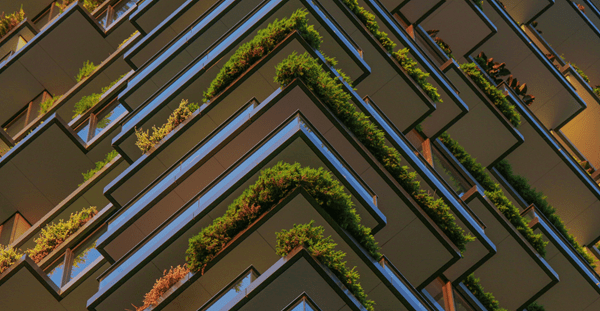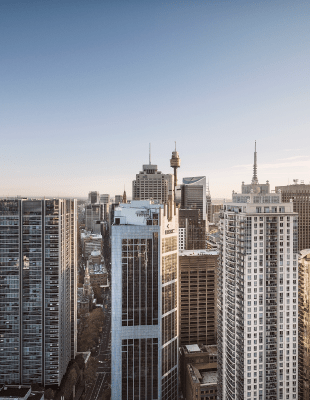The long-known climate crisis is becoming more and more noticeable for everyone.
We understand that design influences our daily lives but also impacts the environment and we can provide innovative ways to address some of the world's most pressing issues affecting our cities and communities, be it regenerative, socially coherent, or commercially sustainable. What's good for the planet is good for communities, buildings, and commerce.
The building sector is one of the largest contributors to climate-damaging emissions, uses a lot of materials, energy resources and green spaces, and leaves behind large amounts of waste. To date, the focus of political measures and environmental policy has been on increasing energy efficiency in the operation of buildings.
However, if the climate protection goals of the Paris Agreement are to be achieved, these measures do not go far enough, other ways must be considered holistically to create a sustainable reality: life cycle of buildings, embodied carbon, and origin of building materials, how they are manufactured, where do the materials end up, preservation of water and biodiversity.
The choice of building material should not only be determined by its carbon footprint but also by the impact on the wider context. Questions arise about reuse, recyclability, conservation of natural resources and the benefits for health and the environment.
Research into climate change from the outset
Advanced digital technology and research groups are important from the outset. Developing and using technology, such as CLIMATESCOUT, that understands climate in a particular location, helps us to design buildings accordingly. Our research from the outset looks at reducing environmental impact and move towards restorative and regenerative systems by working with nature to increase efficiency and harness renewable energy. Using advanced simulation tools, our designers can have a better understanding of environmental impacts.
In North Hills East, America, we adapted natural systems to guide the mixed-use development using the ecological surroundings of a creek corridor. The landscaping and buildings were designed as an extension of the natural creek flora and included open roof drains to direct storm water into native planted bioswales.
Good health and well-being with biophilia design
Using biophilia in our designs promotes well-being by bringing the outdoors in. Efforts to extend green into the built environment take many shapes and forms, whether those be in residential, hospitality, retail or office spaces.
Designing a place that includes locally sourced trees and plant species, possibly water features if climatically sensible, and semi-open humanised and diverse spaces with as much natural light as possible can create an environment that delivers the kind of psychologically soothing and calming effects of nature. While good for people, biophilia helps with the planet too, with usage of natural materials creating fewer emissions and if introduced outdoors enhances biodiversity. By designing climate positive and sustainable buildings that also provide memorable experiences, we amplify the connection to local nature and landscapes, and we expect to see more of this over the next few years as buildings become more sustainable.
Ways to integrate nature externally are green roofs and rooftop farming. Internally, we integrate nature by the use of ‘living walls,’ vertical gardens that serve as a natural air purifier, removing VOCs and other harmful toxins while exhaling oxygen into the space as a by-product of photosynthesis. Living walls help to keep things cool through a process known as evapotranspiration. Studies show that green walls can reduce heat gain by up to 10°c, resulting in significant energy savings, reduced cooling costs and decreased electricity costs (up to 20%). Similarly, the living wall provides an extra layer of insulation, which helps to retain heat in colder temperatures.
Building sustainable communities - the 15-minute city
No project exists in a vacuum; we must evaluate the impact of our work on the surrounding environment but also for the communities. There is no point, for example, building a sustainable building, if all of the inhabitants drive there in emission-heavy petrol cars or energy hungry vehicles. We should be transforming and designing places where all needs are satisfied within walking or cycling distance from home, particularly in larger cities.
A key lies in the blending of uses, while the spaces in between are the glue that need to be activated to allow for more diverse programming and flexibility. The trend is clear that large projects become more and more multi-use neighbourhood destinations that create unique experiences and memories and connect people and communities. After a lack of human interaction during the pandemic years, we are seeing people reclaiming their neighbourhoods with a renewed desire to move away from long commuting and to live close to work and an array of amenities.
We see the trend towards capitalisation of long-neglected pedestrian space, it's no longer just about the buildings. There is a deep understanding that greening the zones between and within buildings benefits well-being of people and commerce, but also the climate.
By prioritising equitable design strategies that decarbonise buildings and emphasise people's experiences, we can create a balance in between work, live and natural habitat for a resilient community and buildings that will redefine the future of cities.
Renewable energy
We must reduce the energy consumption of buildings while also utilising clean, renewable energy. There are many ways to do this on residential properties such as adding solar panels on roofs, and new ground pump heating systems. However, there are ways larger, commercial buildings can also help. At Guadalajara Airport in Mexico, we are working to design the first net-zero airport building, for example, that will feature solar energy harvest points, mechanical cooling systems on the roof, improved daylighting and building management systems to reduce the airport’s energy use by 60% and its carbon footprint by more than 90%.
Retrofit and repurposing with sustainability in mind
Designers and developers do not always have to knock down and start again, re-use can be much better for the environment. We pledge to support reuse by working with existing conditions and making responsible material choices. In Castellana, Madrid, one office project we worked on improving the envelope of the existing building so that it better regulates indoor conditions and provides better daylight, emits less carbon, and even generates its own energy. The office built in 1990 was in need of upgrading and rather than demolish the building, a careful design upgrade for the façade created a high-performance envelope, with photovoltaics generating its own energy and a bioclimate system exposed to the sun that included glass slats for solar protection.
With the planet and people at the heart of our buildings, we work towards a more sustainable world, helping to avoid climate change. The reality of building design is that many strategies can be implemented with minimal additional costs and in the long-term it means our buildings will be cheaper to operate. It is only through wider adoption, research, and collaboration that these costs come down and sustainability becomes mainstream.
Article originally published in Green Living





